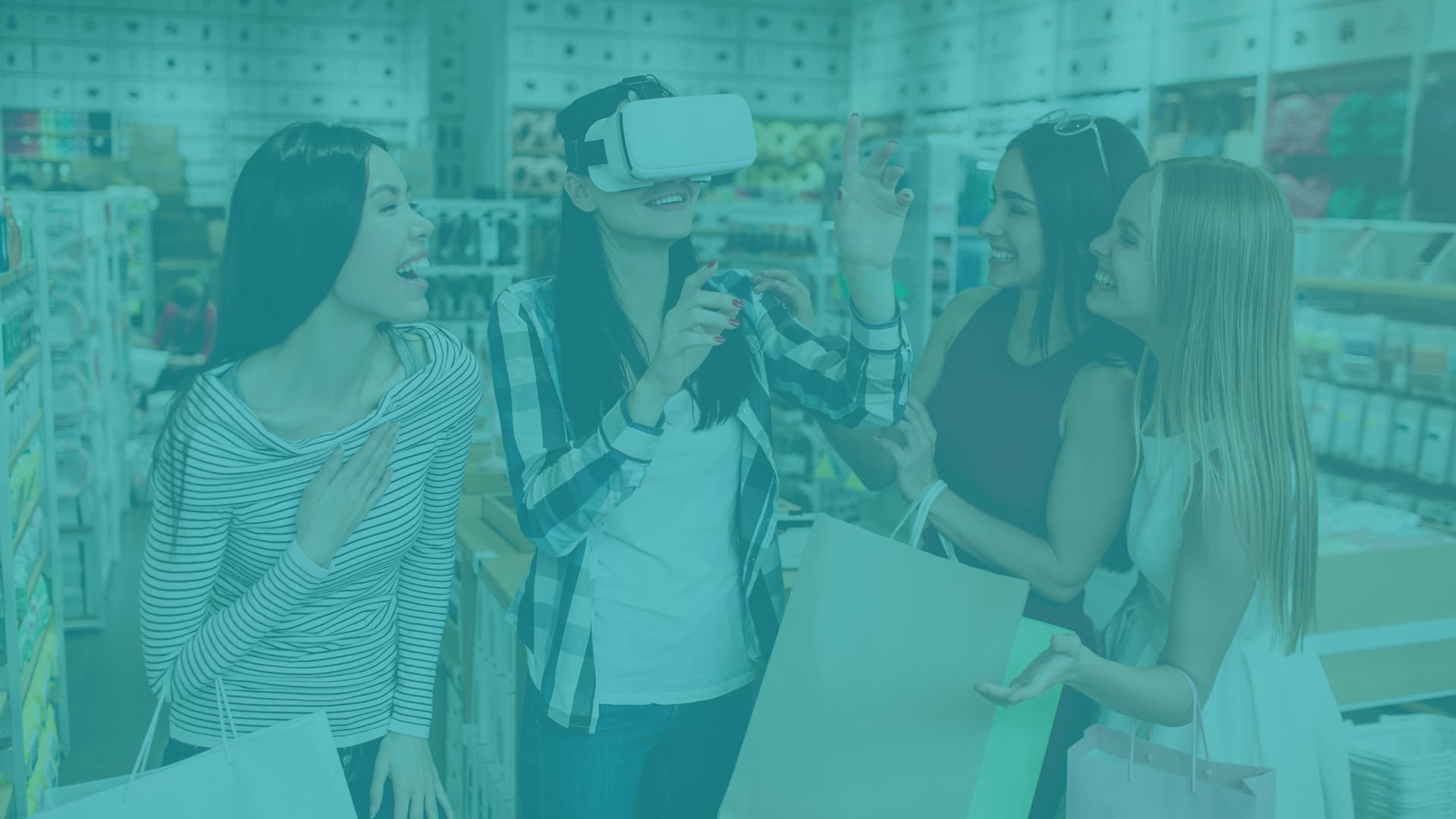Let's Talk !

Since its inception, eCommerce has undergone a dramatic evolution. From early internet ventures to the dotcom bubble of the late nineties and into its current robust and burgeoning incarnation, the eCommerce industry has changed a lot.
As new technologies continue to push various industries into smarter, more connected and exciting directions, eCommerce is on the precipice of yet another monumental transformation.
In the fourth quarter of 2017 alone, more than $3 billion was invested in augmented and virtual reality ventures. Some of the world's biggest companies are involved in the sector–monolithic names such as Apple, Google, Facebook, Microsoft, Sony, Samsung and Alibaba, just to name a few.
However, this is merely the beginning. As reported by Forbes:
"Tim Merel, Managing Director at Digi Capital, forecasts that the AR and VR market will hit $150 billion in revenue by 2020..."
Experts across the globe are predicting that both virtual and augmented reality systems will completely revolutionize the retail and eCommerce industries. Both technologies present extremely disruptive capabilities in allowing consumers to achieve an enhanced and personalized shopping experience that would elevate such interactions to new heights.
Recent studies have shown that a whopping 71 percent of consumers would shop with a specific retailer more often if they offered an AR-enhanced shopping experience and 40 percent of consumers would pay more for a product if they could experience it through augmented reality.
Therefore, both technologies present massive opportunities for eCommerce merchants. Many have been putting these stats to the test by infusing their customer encounters with such features.
For today's eCommerce retailers to remain successful in tomorrow's technological landscape, it is vital to understand how such technologies stand to shape the industry.
Here is exactly how virtual and augmented reality have been altering the eCommerce industry and how they will continue to shape it in the coming months and years.

Over the years, eCommerce has become an exponentially profitable sector as it has provided an ever-more convenient and pleasing modality for consumers to shop from nearly anywhere in the world.
Despite the boom in eCommerce popularity, there have been some intrinsic technological challenges that retailers have had to cope with in building a successful online brand. For instance, while mobile traffic continues to increase year-over-year alongside mobile eCommerce transactions, only 39.6 percent of eCommerce sales were completed on a mobile device as of 2017.
This means that while mobile continues to dominate the digital landscape, merchants still wrestle with closing the conversion gap between desktop and its small screen counterparts. There are several factors driving this disparity.
Firstly, consumers who shop on mobile devices often display a clear intent to browse eCommerce selections as opposed to making a purchase. This is largely the result of the friction presented by mobile retail interfaces.
As mobile devices were not created with online shopping in mind, smaller screens and slower webpage load times can often engender potentially difficult purchasing situations. This is particularly true regarding item comparison and entering personal information in checkout processes. This frequently results in cart abandonment.
However, the challenges presented by mobile shopping experiences can conceivably be remedied through the implementation of augmented reality (AR). Given that most current AR experiences are perceived through smartphone devices, eCommerce interactions can be greatly enhanced through AR's ability to create engaging mobile shopping encounters via product visualization.
Through the use of augmented reality features, consumers are encouraged to spend increasing amounts of time visualizing and configuring products in real-world environments, eliminating many of the questions and concerns that come from online shopping.
For instance, British eCommerce merchant Banana Flame collaborated with the AR company Zugara to transform consumer webcams into interactive "mirrors." This enabled consumers to see what an outfit would look like on them before making a purchase. The implementation resulted in a 182 percent increase in the number of items added to carts for Banana Flame.
Similarly, IKEA recently released a similar type of AR application that allows shoppers to view what specific home furnishings would look like in their dwelling before bringing the item home. This same scheme was employed by the home and lifestyle brand Magnolia Market.
Another home design company, Houzz, utilized this same type of AR functionality and found that doing so resulted in an 11 times lift in consumer purchase likelihood, in addition to keeping them on the application 2.7 times longer.
While many of these companies are on the small-to-medium end of the organizational spectrum, mammoth-sized companies like Amazon are also getting in on the benefits touted by augmented reality's merger with eCommerce.
In late 2017, Amazon unveiled its AR View feature in its application. This addition works in the same way as the aforementioned IKEA and Houzz AR elements, but for now is limited to select items. However, Amazon does intend to continue to expand its catalog of AR-enabled products so that shoppers can get a better sense of what they are buying.
With Amazon's AR View, consumers can rotate items and place them in locations around their home to gain a decent understanding of the product's size and look, providing a heightened sense of satisfaction and confidence.
This type of functionality not only serves to increase sales and assurance in one's purchase, but it also provides the added benefit to merchants that expenditures related to returns and exchanges will be minimized, ultimately reducing company overhead in that department.
While AR presents incredibly promising developments for the eCommerce industry, the technology's counterpart–virtual reality–also holds a bevy of potential new benefits.

Virtual reality (VR) was touted as a game-changing technology several years back; however, the tech has been somewhat slow to latch on despite the potential it still holds.
In the eCommerce space, virtual reality has been leveraged in a partnership between Australian retailer Myer and eBay, who came together to launch the first-ever fully virtual department store.
Utilizing the company's "Shoptical" cardboard VR viewers, consumers can enter a personalized digital shopping experience that mimics an in-store encounter. When customers add items to their cart, related products are then displayed, adding a layer of discoverability that continues to guide their shopping adventure based on personal preferences.
Through this interface, consumers can view items from any desired angle and are given the freedom to zoom, rotate and move products as they please, bringing digital shopping to a new level and utterly diminishing the advantages previously held by in-store experiences. Moreover, this type of interaction makes the current 2D model of eCommerce shopping seem antiquated.
In a similar vein, Shopify has leveraged VR technology to create the Thread Studio, which the company proclaims "...transports you into a virtual photo studio where you can upload designs and lay them out on mannequins wearing American Apparel shirts." The Thread Studio utilizes the actual bodily proportions of shoppers so that they can gain a more comprehensive understanding of how clothing items will fit in real life.
These use cases seem to closely mimic those of AR technology, creating redundancies; however, given that VR demands additional hardware requirements, it seems as if AR is the superior choice for eCommerce shopping.
However, many experts believe that VR better serves the eCommerc world not in shopping, but in marketing and branding.
TOMS, the charitable footwear brand, has begun incorporating VR technology into its branding efforts by using the tech to allow viewers to journey alongside a TOMS customer who travels from California to deliver donated shoes to underprivileged children in Colombia–a powerful demonstration of how a consumer's buying decisions could impact others across the world. Additionally, such a concept leverages emotional triggers that drive consumers to resonate with TOMS altruistic services that are directly tied to the company's sales.
In similar fashion, home improvement superstore Lowe's has also leveraged VR technology to enhance its branding and marketing efforts by incorporating virtual in-store training sessions.
Such experiences help users gain basic do-it-yourself skills and show them the supplies needed to complete specific projects. Through this initiative, Lowe's found that using VR in this manner resulted in customers achieving 40 percent greater retention in the materials learned.
In the end, it appears that augmented reality technology applications are better suited toward the actual shopping experience, while VR can be leveraged to effectively enhance marketing and branding initiatives that resonate with consumers.
However, both technologies show incredible promise in helping to push the eCommerce industry forward into its next incarnation, delivering more immersive and informative experiences for customers. These new applications can help solve a variety of intrinsic challenges faced by eCommerce merchants the world over.
Additionally, thanks to the proliferation of cost-effective headsets (such as Google Cardboard), creating augmented shopping experiences is becoming an increasingly feasible goal for even the smallest of retailers. While VR headsets are much costlier, in time, prices will drop and this tech will also become a mainstay of the eCommerce arena.
In the meantime, retailers should focus on creating incredibly well-designed and optimized store experiences that serve the current market, while setting themselves up for the next evolution of eCommerce interactions.
About the Author
Ronald Dod
CMO and Co-founder at Visiture.com
Ronald Dod is the Chief Marketing Officer and Co-founder of Visiture, an end-to-end eCommerce marketing agency focused on helping online merchants acquire more customers through the use of search engines, social media platforms, marketplaces, and their online storefronts. His passion is helping leading brands use data to make more effective decisions in order to drive new traffic and conversions.
Website: www.visiture.com
LinkedIn: linkedin.com/in/ronalddod
Twitter: @Visiture_Search
Facebook: @visituresearchmarketing
Disclaimer:
Chetu does not affect the opinion of this article. Any mention of a specific software, company or individual does not constitute an endorsement from either party unless otherwise specified. This blog should not be construed as legal advice.
Founded in 2000, Chetu is a global software development agency, delivering solutions and support services. Chetu's specialized technology and industry experts serve startups, SMBs, and Fortune 500 companies with an unparalleled software delivery model suited to the needs of the client. Chetu's one-stop-shop model spans the entire software technology spectrum. Headquartered in Plantation, Florida, Chetu has fourteen locations throughout the U.S. and abroad.
Privacy Policy | Legal Policy | Careers | Sitemap | Referral | Contact Us
Copyright © 2000-2024 Chetu Inc. All Rights Reserved.
